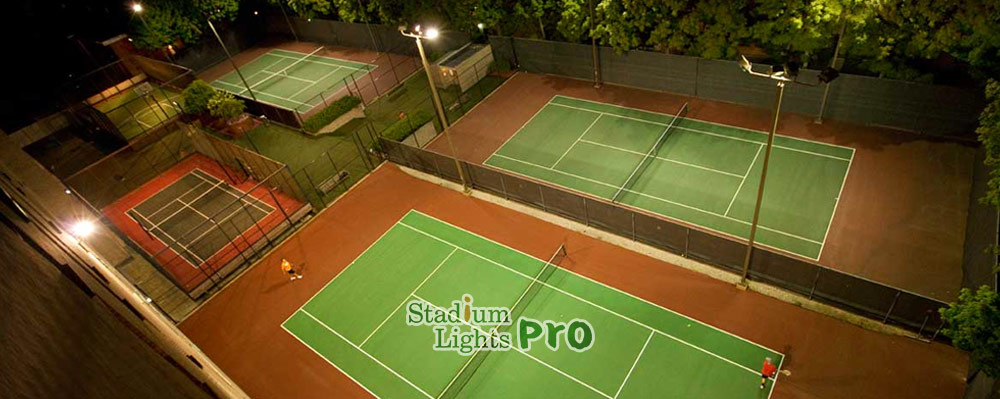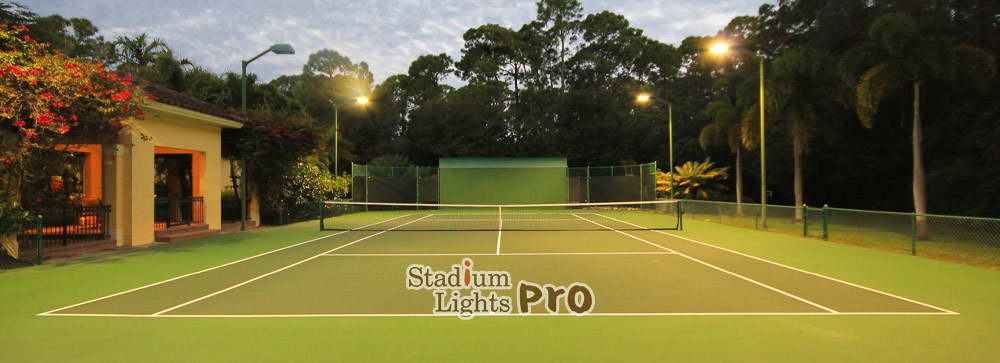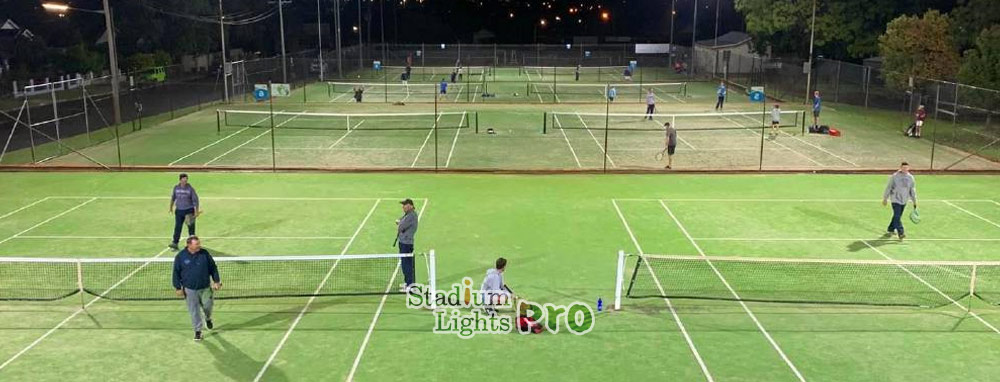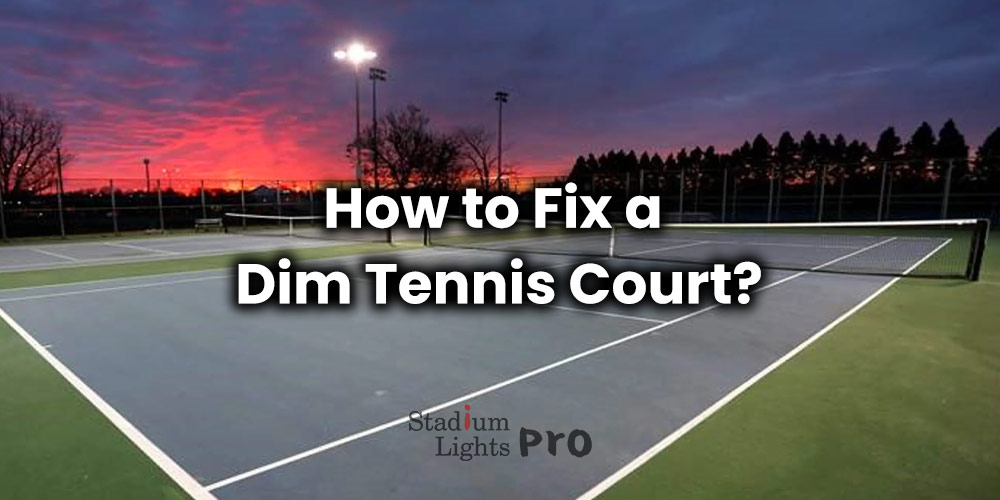Table of Contents
ToggleWhy is my tennis court dim?
To determine the cause of dimness on a tennis court, you will need to consider a variety of potential factors. Some possible causes of dimness could include:
Wear and tear

Over time, the surface of the court may become worn or damaged due to normal use, as well as exposure to the elements. This can result in a loss of shine or brightness, making the court appear dim.
To address wear and tear on a tennis court, you may need to perform repairs or resurfacing to restore the court’s surface. This can involve filling in cracks or divots, smoothing out rough areas, and applying a new finish to the court. In some cases, the entire court may need to be resurfaced to restore its brightness.
To prevent wear and tear on a tennis court, we need to properly maintain the court and protect it from the elements. This can include regularly sweeping and cleaning the surface, repairing damage as needed, and using protective coverings or barriers to shield the court from the sun, rain, and other weather conditions.
Lighting issues
If the court’s lighting fixtures or bulbs are not functioning properly, it can result in dim or uneven lighting on the court.
To fix the lighting issues on a tennis court, you may need to repair or replace the lighting equipment. This could involve replacing burned-out bulbs, repairing or replacing damaged fixtures, or adjusting the angle or positioning of the fixtures to improve lighting on the court.
It is necessary to ensure that the court has adequate lighting to allow players to see the ball and each other clearly. This may involve installing additional tennis court lighting fixtures or using specialized lights, such as shadow-eliminating or pole-mounted lights, to reduce shadows on the court. Using energy-efficient lighting, such as LED floodlights, can help to reduce energy costs and minimize the environmental impact of lighting the court.
Fixing dim tennis court with proper lighting design
Make sure the court has adequate lighting

Adequate lighting is essential for a tennis court to ensure that players can see the ball and each other clearly. Poor lighting can affect the safety and enjoyment of play, as well as the overall appearance of the court.
Check the lighting equipment
To check the lighting equipment on a tennis court, you will need to inspect the fixtures and bulbs to ensure that they are functioning properly.
Inspect the fixtures
Look for any signs of damage, such as dents, cracks, or loose parts. If the fixtures are damaged, they may need to be repaired or replaced.
Check the bulbs
Make sure that all bulbs are securely fastened in place and not burned out. If any bulbs are burned out, they should be replaced with new ones.
Test the lighting
Turn on the court’s lighting and walk around the court to ensure that it is evenly distributed and providing adequate illumination. If you notice any areas that are particularly dim or overly bright, you may need to adjust the angle or positioning of the fixtures.
Check the wiring
Make sure that all wiring is securely fastened and not frayed or damaged. If the wiring is damaged, it should be repaired or replaced.
Check the power supply
Make sure that the court’s lighting is properly connected to a power source and that the power source is functioning properly.
Consider the time of day
The lighting needs of a tennis court may vary depending on the time of day and the season. For example, courts may need more lighting in the winter months when there is less natural light.
The intensity of natural light
During the day, the intensity of natural light will vary depending on the time of day, the weather, and the location of the court. Courts located in sunny, open areas may need less lighting than courts located in shaded or partially covered areas.
The time of day
The amount of natural light available will also vary depending on the time of day. Courts used in the morning or evening may need more lighting than courts used during the middle of the day when natural light is more abundant.
The season
The amount of natural light available will also vary depending on the season. Courts used in the winter months may need more lighting than courts used in the summer when there is more daylight.
Consider the location of the court
The lighting needs of a tennis court may also be affected by its location and surrounding environment. Some specific factors to consider when evaluating the location of a court include:
The surrounding landscape
The amount of natural light that a court receives may be affected by the surrounding landscape, such as trees, buildings, and hills. For example, a court located in a valley may receive less natural light than a court located on a hill.
The orientation of the court
The orientation of the court, or the direction it faces, can also affect the amount of natural light it receives. A court facing north may receive less natural light than a court facing south.
The surrounding structures
Structures, such as buildings or fences, may block or reflect natural light onto the court.
Use light-colored surfaces
Using a light-colored surface for a tennis court can help to reflect light and improve visibility for players. Light-colored surfaces, such as white or pale gray, can help to reflect light back onto the court and make it easier for players to see the ball against a bright background.
Painted surfaces
A light-colored paint, such as white or pale gray, can be applied to the surface of the court to reflect light. This may involve repainting the entire court or adding a coat of paint over an existing surface.
Synthetic surfaces
Synthetic surfaces, such as acrylic or polyurethane, are available in a range of light colors and can be applied to the court to provide a bright, reflective surface.
Natural surfaces
Some natural surfaces, such as crushed stone or sand, can be used to create a light-colored surface for a court. However, these surfaces may not be as durable or consistent as synthetic surfaces.
Use shadow-eliminating lights
Shadow-eliminating or pole-mounted lights can be used to reduce shadows on a tennis court and improve visibility for players. These specialized lights are mounted on poles or other structures and are designed to eliminate or minimize shadows on the court.
Improved visibility
By reducing shadows on the court, shadow-eliminating lights can help to improve visibility for players and make it easier for them to see the ball and each other.
Enhanced safety
Shadows on a tennis court can make it difficult for players to see the ball and anticipate its movement, which can increase the risk of injury. By eliminating shadows, shadow-eliminating lights can help to improve safety on the court.
Enhanced aesthetics
Shadows can affect the overall appearance of a court and make it appear dim or unevenly lit. By eliminating shadows, shadow-eliminating lights can help to improve the appearance of the court and make it more visually appealing.
Use energy-efficient lighting
Using energy-efficient lighting, such as LED bulbs, can help to reduce energy costs and minimize the environmental impact of lighting a tennis court. LED bulbs are a popular choice for court lighting due to their long lifespan, energy efficiency, and bright, consistent light output.
Reduced energy costs
LED bulbs are more energy-efficient than traditional bulbs, such as incandescent or halogen bulbs. This can result in lower energy bills and reduced operating costs for the court.
Improved lighting quality
LED bulbs provide a bright, consistent light output that is ideal for sports such as tennis. They also produce less heat than traditional bulbs, which can help to reduce the risk of overheating or damage to the lighting equipment.
Environmental benefits
LED bulbs are more energy-efficient than traditional bulbs, which means they use less electricity and produce fewer greenhouse gas emissions. This can help to reduce the environmental impact of lighting a tennis court.
How to improve the brightness of the tennis court?

There are 3 side-by-side tennis courts, and the poles are on the far end of the court, so the middle court is dark, how can I fix it? There are a few options you could consider to improve lighting on the middle tennis court:
Install additional lighting fixtures on the middle court
To improve lighting on the middle court in a group of three courts that are side-by-side, you may need to install additional lighting fixtures on the middle court. This could involve mounting fixtures on poles or attaching them to existing structures, such as buildings or fences.
Placement
The position of the lighting fixtures will be essential to ensure that they provide adequate lighting on the court. It may be necessary to adjust the angle or height of the fixtures to minimize shadows and ensure that the lighting is evenly distributed across the court.
Wiring
You will need to ensure that the lighting fixtures are properly connected to a power source and that the wiring is secure and in good condition. If the wiring is damaged or faulty, it could pose a safety risk and may need to be repaired or replaced.
Compatibility
It is recommended to ensure that the lighting fixtures are compatible with the existing electrical system and that they meet any relevant safety standards.
Maintenance
Regularly inspecting and maintaining the lighting fixtures can help to ensure that they are functioning properly and providing adequate lighting on the court. This may involve replacing burned-out bulbs, repairing or replacing damaged fixtures, and adjusting the angle or positioning of the fixtures as needed.
Use portable lighting solutions
Portable lighting solutions, such as temporary floodlights or spotlights, can be used to provide additional lighting on a tennis court as needed. These types of lights can be set up on the court and positioned to provide additional illumination where it is needed.
Flexibility
Portable lighting solutions can be set up on the court as needed and moved or repositioned as required. This can be useful if the court is used at different times of day or in different seasons, when the lighting needs may vary.
Quick and easy setup
Portable lighting solutions are typically easy to set up and take down, which can make them a convenient option for providing temporary lighting on a court.
Versatility
Portable lighting solutions are available in a range of sizes and styles, which can make it easy to find a solution that meets the specific lighting needs of a court.
Use reflective materials
Using reflective materials, such as light-colored paint or tape, can help to reflect light and improve visibility on a tennis court. Reflective materials can be applied to the surface of the court or to the edges of the court to reflect light back onto the court and make it easier for players to see the ball against a bright background.
Reflective paint
A light-colored, reflective paint can be applied to the surface of the court to reflect light and improve visibility. This may involve repainting the entire court or adding a coat of paint over an existing surface.
Reflective tape
Reflective tape, such as reflective hazard tape, can be applied to the edges of the court or to other areas of the court to reflect light and improve visibility.
Reflective markers
Reflective markers or markers with reflective tape can be placed on the court to reflect light and help players see the ball and the court lines more clearly.
Use light-colored tennis balls
Using light-colored tennis balls can help to improve visibility and make it easier for players to see the ball on the court. Light-colored balls, such as yellow or white, can be more visible against a bright or light-colored background, which can make it easier for players to track the ball and anticipate its movement.
Improved visibility
Light-colored balls can be more visible against a bright or light-colored background, which can make it easier for players to see the ball and track its movement.
Enhanced safety
If players are able to see the ball more clearly, they may be less likely to suffer eye injuries or collide with each other on the court.
Enhanced enjoyment
Being able to see the ball more clearly can improve the overall enjoyment of play and make it easier for players to focus on the game.
Conclusion
There are several steps you can take to improve lighting on a tennis court and ensure that it is adequately lit for play. Some of these steps include installing additional lighting fixtures, using specialized lighting solutions, using light-colored surfaces, adjusting the position of the existing lighting fixtures, and using energy-efficient lighting.
If you are looking to improve the lighting on your tennis court, we can help. Our team of experts can provide a free lighting design service to help you determine the best way to fix your dim court. We can also provide professional installation and repair services to ensure that your court has adequate lighting for safe and enjoyable play. Please don’t hesitate to contact us for more information or to schedule a consultation. We are dedicated to helping you create a well-lit, high-quality tennis court that meets your needs and budget.

